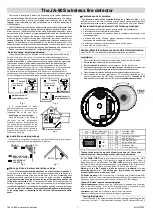
FXAlg #952: Expander
Algorithm Reference-142
FXAlg #952: Expander
A stereo expansion algorithm
Allocation Units:
1
This algorithm expands the signal (reduces the signalÕs gain) when the signal falls below the expansion threshold.
The amount of expansion is based on the larger magnitude of the left and right channels. The amount of expansion
is expressed as an expansion ratio. Expanding a signal reduces its level below the threshold. The expansion ratio is
the inverse of the slope of the expander input/output characteristic. An expansion ratio of 1:1 will have no effect on
the signal. A zero ratio (1:
¥
), will expand all signal levels below the threshold level to the null or zero level.
(Maximum expansion for this expander is 1:17.) Thresholds are expressed as a decibel level relative to digital full-
scale (dBFS), where 0 dBFS is digital full-scale and all other available values are negative.
Expander
To determine how much to expand the signal, the expander must measure the signal level. Since musical signal
levels will change over time, the expansion amounts must change as well. You can control how fast the expansion
changes in response to changing signal levels with the attack and release time controls.
The attack time is defined as the time for the expansion to turn off when the signal rises above the threshold. This
time should be very short for most applications. The expander release time is the time for the signal to expand down
after the signal drops below threshold. The expander release time may be set quite long. An expander may be used
to suppress background noise in the absence of signal, thus typical expander settings use a fast attack (to avoid
losing real signal), slow release (to gradually fade out the noise), and the threshold set just above the noise level.
You can set just how far to drop the noise with the expansion ratio.
Expansion Transfer Characteristic
Delay
Delay
Expander
Expander
Sum
Magnitude
Magnitude
Sum
Feedback/Feedforward
Switches
Out Gain
L Output
R Output
L Input
R Input
Expander
Computation
Out
Amp
In Amp
Threshold
















































